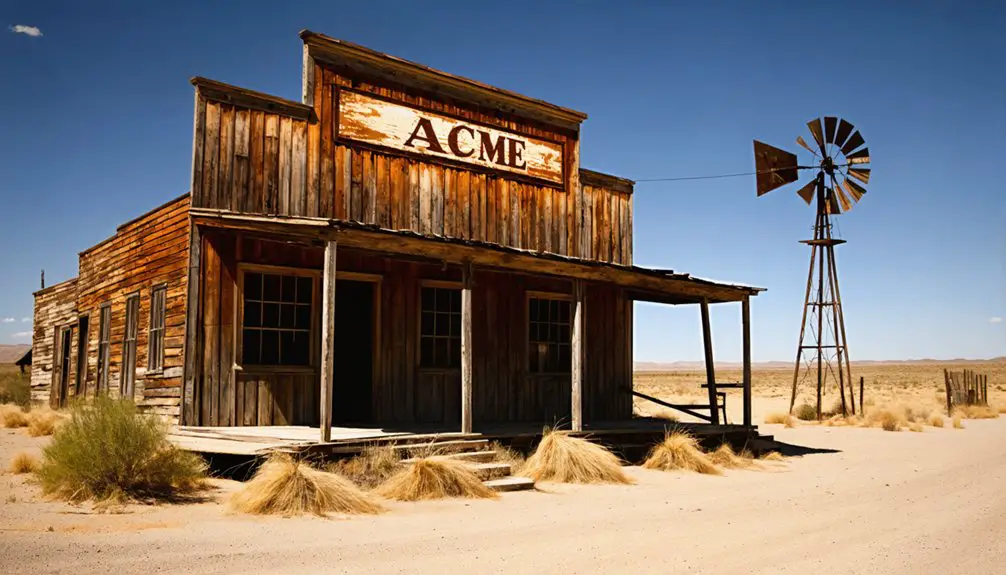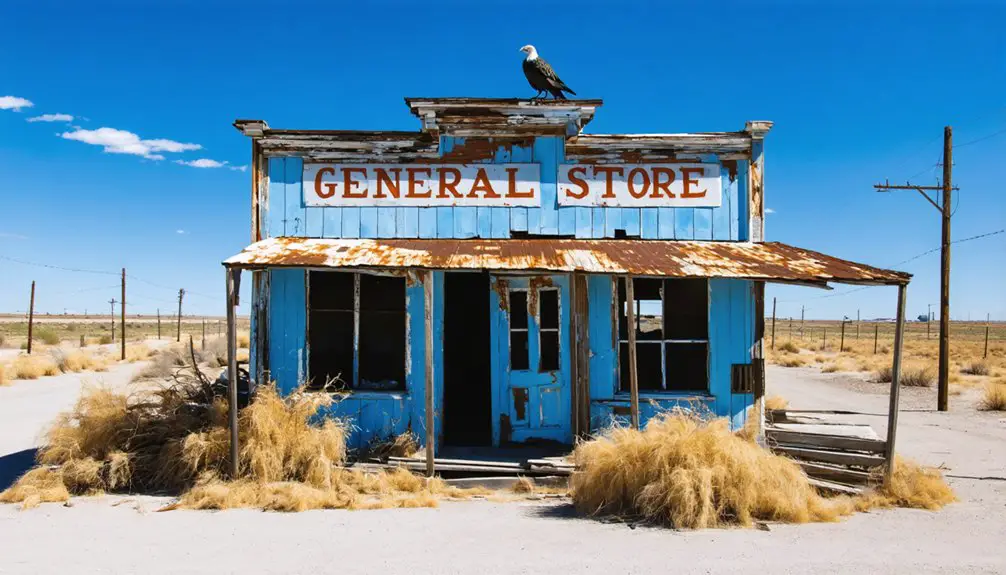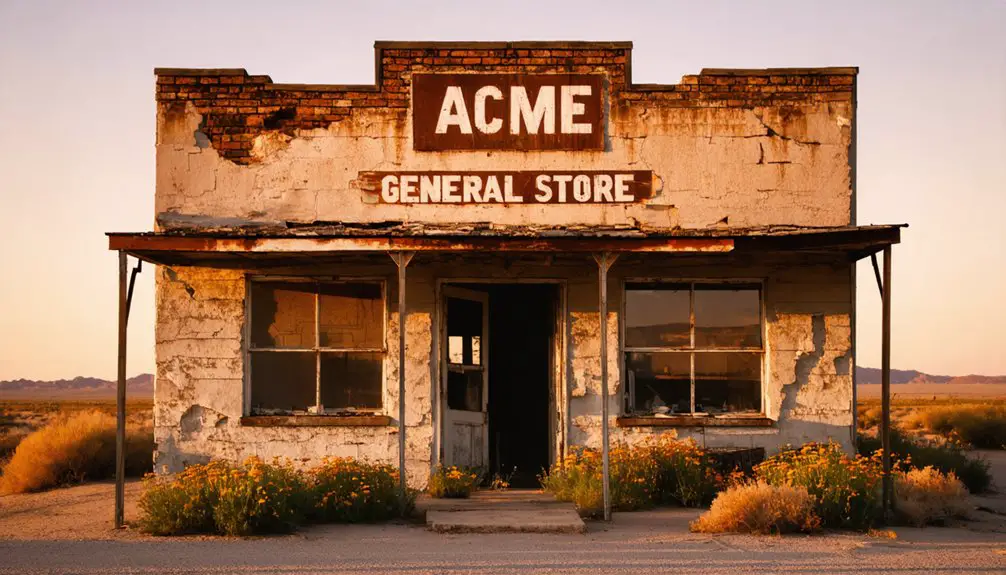You’ll find Acme’s ghostly remnants along Grosbeck Creek in Hardeman County, where James Sickler’s 1890 gypsum discovery sparked an industrial boom. This once-thriving company town supported 400 residents with its mills, railroad depot, general store, and school. The Acme Tap Railroad connected the bustling gypsum plants to major shipping lines until the Great Depression hit. Today, scattered ruins and concrete foundations tell tales of Texas’ forgotten mining heritage.
Key Takeaways
- Acme, Texas began as a thriving gypsum mining town in 1890, reaching its peak population of 400 residents by 1945.
- The town featured essential services including a post office, hotel, railway depot, general store, and company houses for workers.
- Three railroads served the community, with the Acme Tap Railroad being crucial for connecting gypsum plants to broader markets.
- Economic decline began during the Great Depression, with plant closures and natural disasters leading to population decrease.
- By 1975, the once-prosperous mining town had dwindled to just 14 residents, with only scattered ruins remaining today.
The Rise of a Gypsum Mining Town
When James Sickler stumbled upon rich gypsum deposits along Grosbeck Creek in 1890, he’d set in motion the birth of what would become Acme, Texas. He quickly moved his Kansas processing plant to tap into this treasure trove, sparking a wave of gypsum exploration in northeast Texas.
You’ll find this wasn’t just any mineral deposit – it was part of the Van Vacter Member of the Blaine Formation, a massive Permian-age bed stretching 150 miles through Texas. Soon, two competing mills sprang up along the creek, leading to fierce industrial rivalries. The Acme Cement Plaster Co. established by Samuel Lazarus became a major industrial force by 1898.
The mineral extraction boom transformed Acme into a bustling hub, complete with a hotel, railway depot, and school. By the early 1900s, you’d have found yourself in one of Texas’s major gypsum production centers, with CertainTeed Products Corporation leading the charge. Workers even discovered prehistoric mastodon remains during their excavation work.
Life in Early Acme
Nearly every aspect of life in early Acme revolved around the gypsum mills, from the company houses where workers lived to the carefully positioned schoolhouse built away from the dust and smoke.
You’d find the essentials of small-town Texas life here – a bustling hotel, railway depot, general store, and post office serving about 400 folks at its peak.
The community’s resilience showed in how they started their school in a tent back in 1907 before building a proper one-room schoolhouse. The post office operated from 1906 until 1946, closing after the mill’s shutdown led to population decline. Kids faced educational challenges, having to bring their own books and supplies, but they made do.
Life wasn’t fancy, but the power plant’s arrival in 1911 brought electricity to both homes and industry, marking real progress for this hardworking mining town. The discovery of prehistoric mastodon fossils during gypsum excavation added an unexpected dimension to the town’s mining operations.
Industrial Development and Innovation
The discovery of gypsum beds along Grosbeck Creek in the 1890s transformed Acme from a quiet Texas town into an industrial powerhouse.
A single mineral discovery in the 1890s catapulted a sleepy Texas town into an unexpected industrial revolution.
You’d have seen major industrial innovation taking shape as the Lone Star Cement Plaster Company and rival mills set up shop, spurring the creation of the Acme Tap Railroad to handle their shipping needs.
The town’s technological advancements really kicked into high gear when they brought in game-changing equipment like the Boyd Press for brick making and a massive 400-foot gas-fired tunnel kiln that could crank out over 2,000 bricks per hour.
The switch to natural gas firing and stiff-mud production methods put Acme on the cutting edge of manufacturing efficiency, while the growing rail network kept those products moving to market. Much like George Bennett’s vision in 1891, the town’s industrial growth was built on recognizing the demand for quality construction materials. Their innovative spirit continued through the decades, eventually leading to Warren Buffett’s acquisition in 2000.
The Acme Tap Railroad Legacy
If you’re looking for a prime example of how crucial even the smallest railroads were to Texas industry, you’ll find it in the 1.51-mile Acme Tap Railroad that connected local gypsum plants to the main Fort Worth and Denver City line.
Built in 1899 by the Salina Cement Plaster Company, this short but mighty line broke through competitive barriers and guaranteed the region’s plaster products could reach broader markets. The railroad navigated complex industrial relationships since one plant required crossing rival land to access the line.
Samuel Lazarus initiated the Acme, Red River and Northern Railway that later became part of the QA&P network. You can trace the line’s influence through its later connections to the Quanah, Acme and Pacific Railway until its final closure in 1938, marking both the rise and fall of Acme’s industrial era.
Short But Essential Line
Running just 1.51 miles through Hardeman County, Texas, Acme Tap Railroad proved that even the shortest rail lines could pack an outsized punch in American industrial development.
You’d be amazed how this tiny stretch of track, chartered in 1899, solved a major headache for the Salina Cement Plaster Company when a rival plant blocked their rail access.
Similar to how plantation owners contributed labor for railroad construction in Brazoria County, local industry played a vital role in establishing and maintaining the line.
The railroad’s significance went beyond its modest length. By connecting the Salina plant to the Fort Worth and Denver City mainline, it kept local industry humming and gypsum production flowing.
The economic impact rippled through Acme as private spurs expanded to connect more deposits to the line.
Even though the track’s story ended in 1938 after the plant’s closure, it showed how a determined company could use railroad rights to outmaneuver obstacles and keep business moving.
The region’s rich railroad heritage is now preserved at the Spanish Colonial Revival style museum in downtown Quanah.
Connecting Industry Through Rails
Built on necessity and business savvy, Acme Tap Railroad‘s legacy extends far beyond its humble physical footprint.
You’ll find this rail infrastructure served as the lifeblood for Hardeman County’s bustling gypsum industry, connecting the Salina Cement Plaster plant to the Fort Worth and Denver City mainline.
When Sam Lazarus wouldn’t grant an easement across his property, the Salina company didn’t back down – they created their own common-carrier railroad.
This industrial transportation link proved essential, with FW&DC handling the switching operations while the Quanah, Acme and Pacific Railway later expanded the region’s reach.
Though just 1.51 miles long, the Acme Tap shows how Texas entrepreneurs used railroads to overcome obstacles and build local industry, lasting until the Salina plant’s closure in 1931.
Sudden Rise And Fall
Though the Acme Tap Railroad spanned just 1.51 miles, its story packs a hefty punch in Texas railroad history.
You’ll find that this tiny stretch of track, born from a property dispute in 1899, became the lifeline for two rival plaster companies fighting for their piece of the industrial pie.
From the get-go, this scrappy short line defied the odds. Operating under various leases, including the Fort Worth and Denver City Railway, it kept the gypsum products flowing to market.
But like many economic changes of the early 20th century, the good times couldn’t last forever. When the Salina plant shut its doors in 1931, the writing was on the wall.
Community Growth and Peak Years
You’ll find Acme’s most prosperous period stretched from the late 1920s through the mid-1940s, when the population swelled from 75 to nearly 400 residents.
The town’s growth rode on the success of its gypsum operations, particularly the CertainTeed Products Corporation plant, which ranked among the nation’s largest gypsum facilities.
Local families enjoyed steady employment and a bustling community complete with a post office, general store, hotel, and school – all the makings of a proper Texas industrial town.
Population Growth to 400
As the gypsum industry took hold in the early 1900s, Acme’s population steadily climbed from just 25 folks in the mid-1920s to around 75 by decade’s end.
The community evolution showed remarkable growth, with population dynamics driven by the booming gypsum operations. By 1940, you’d find about 150 residents calling Acme home, and just five years later, the town hit its peak with 400 souls.
- CertainTeed Products Corporation ran one of the nation’s largest gypsum plants right there in town
- Folks had everything they needed – a hotel, railway depot, general store, and school
- Three railroads served the area, making it easy to ship products and bring in supplies
- The post office (est. 1898) helped cement Acme’s status as a proper town
Industrial Prosperity Drives Development
The industrial muscle behind Acme’s remarkable growth came from its bustling gypsum operations, starting with James Sickler’s Lone Star Cement Plaster Company in the 1890s.
You’d have seen multiple gypsum mills spring up along Grosbeck Creek, with rival companies fighting for rail access until the Acme Tap Railroad Company settled matters in 1899.
Natural Challenges and Economic Struggles

Devastating floods in 1926-1927 marked the beginning of Acme’s long economic decline, when the Little Washita River overflowed and buried valuable gypsum beds under feet of sand.
When floodwaters buried Acme’s precious gypsum deposits in 1926, they also buried the town’s hopes for prosperity.
You’d be hard-pressed to find a town less prepared for the double-whammy of natural disasters and the Great Depression that followed. The town’s economic resilience was tested as mining costs skyrocketed and profits plummeted.
- Railroad rivalries forced the creation of the Acme Tap Railroad Company, driving up operational costs
- Mining became increasingly difficult as flood-deposited sediment covered the gypsum beds
- Population peaked at 400 in 1945 before the industry’s collapse
- By 1975, only 14 folks remained in town, watching their once-bustling community transform into a ghost town
The Great Plant Shutdown
While most folks remember the Great Depression hitting Acme hard, you’d be surprised to learn the town’s industrial troubles started much earlier with Acme Pressed Brick Company‘s major shutdown in 1910.
Things got worse when the plant caught fire in 1914 right after repairs, and then the Depression delivered the knockout punch. You couldn’t miss the devastating impact of plant closures – sales dropped 40%, and sixteen out of twenty-eight sales offices vanished in just two years.
The economic decline hit the community like a ton of bricks, literally. By 1975, what was once a bustling town of 400 souls in 1945 had dwindled to just 14 people.
The final blow came recently when Georgia-Pacific shuttered its operations in 2023, displacing 166 workers.
Remnants of a Bygone Era

Standing as silent witnesses to Acme’s once-thriving industrial past, scattered ruins and partially intact structures dot the landscape where 400 residents once called home.
You’ll find historical significance in every corner, from the sturdy railroad depot that’s weathered decades to the repurposed concrete from the old mill building. The town’s community memories live on through these remnants, telling stories of bustling industry and small-town life.
- The original railroad depot still stands proud, reminding visitors of the town’s essential rail connections
- Concrete foundations peek through the soil, marking where the general store and hotel once served locals
- Georgia Pacific’s massive mill left its mark through locally repurposed concrete
- Natural reclamation has transformed old roads and infrastructure into haunting reminders of prosperity
Archaeological and Paleontological Discoveries
Beyond the visible remnants of Acme’s industrial past lies an even richer historical treasure trove beneath the soil.
You’ll find fascinating mastodon fossils discovered during 1890s gypsum mining operations, showcasing the area’s paleontological significance during the Ice Age. These well-preserved skeletal remains tell the story of massive creatures that once roamed North Texas during the Pleistocene epoch.
While you won’t find direct evidence of early humans at Acme itself, the surrounding region boasts archaeological indicators of human activity dating back 16,000-20,000 years.
Today’s metal detecting enthusiasts regularly uncover pieces of Acme’s more recent past – from porcelain doorknobs to old lighters scattered among the riverbeds and former town sites, painting a vivid picture of life in this once-bustling mining community.
Preserving Acme’s Heritage

Despite decades of neglect and demolition, efforts to preserve Acme’s heritage continue through a mix of local historical societies, dedicated authors, and community remembrance.
You’ll find heritage preservation happening through both physical remnants and storytelling, with local historians like Gwen Jackson and Brunetta Griffith documenting the town’s rich gypsum mining history.
The railroad depot still stands as a symbol of Acme’s industrial past, though many original structures didn’t survive the town’s decline.
- Historical documentation through oral histories keeps former residents’ memories alive
- Local museums showcase Acme’s role in Texas’ mining heritage
- The Georgia Pacific Corporation maintains industrial presence, indirectly preserving the site’s legacy
- Original gypsum plant infrastructure remains as a physical link to the town’s founding era
Frequently Asked Questions
Are There Any Ghost Stories or Supernatural Legends Associated With Acme?
You won’t find documented haunted tales or ghost sightings here – unlike other Texas ghost towns that draw supernatural tourism. The town’s ghostly reputation comes purely from its abandoned status.
Can Visitors Legally Explore the Remaining Structures in Acme Today?
Like a padlocked gate blocking your path, you can’t legally explore Acme’s structures without permission. Visitor access requires contacting property owners first since legal restrictions protect these privately-owned buildings.
What Happened to the Mastodon Fossils Discovered During Mining Operations?
You won’t find those mastodon fossils today – there’s no record of proper fossil preservation or formal excavation after their 1890s discovery. They’re likely lost to time or destroyed during mining operations.
Did Any Famous People or Historical Figures Ever Visit Acme?
Despite its peak population of 400 residents, you won’t find records of any famous visitors or historically significant figures ever coming to Acme – it was strictly a working-class gypsum mill town.
Were There Any Major Crimes or Notable Incidents in Acme’s History?
You won’t find any major crime statistics from Acme’s past. The town’s most notable incidents were strictly business-related, mainly involving competition between rival plaster companies over railroad access rights.
References
- https://en.wikipedia.org/wiki/Acme
- https://cityofdust.blogspot.com/2016/03/a-tale-of-two-towns-acme-frazier-nm.html
- https://www.southwestledger.news/news/former-mill-town-acme-now-ghost-its-former-self
- https://freepages.history.rootsweb.com/~gtusa/usa/tx.htm
- https://www.allacrosstexas.com/texas-ghost-town.php?city=Acme
- https://en.wikipedia.org/wiki/List_of_ghost_towns_in_Texas
- https://www.texasescapes.com/TexasTowns/Acme-Texas.htm
- https://www.youtube.com/watch?v=iJdN4B7Fo0s
- https://www.tshaonline.org/handbook/entries/acme-tx
- http://txrrhistory.com/towers/027/027.htm



